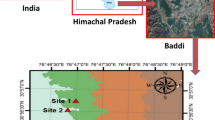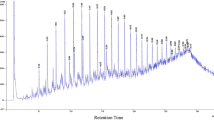Abstract
Production water collected from the “Nafoora” oil water pit, located near the Gallo Oasis, Libya, was used for the screening of obligate hydrocarbonoclastic bacteria that can degrade crude oil. Bacterial strain NAF1 was isolated and characterized after enrichment on crude oil at pH 7 and 30 °C. Solid Waste Dates (SWD) and Corn Steep Liquor (CSL) were usedas to enhance biodegradation of crude oil. Strain NAF1 was able to utilize a number of aliphatic and aromatic hydrocarbons. During growth on natural products, high emulsifying activity in the presence of cells was also observed, which indicated the production of biosurfactant by strain NAF1. The new isolated strain NAF1 produced a yellow-green pigment. The bacterial strain showed removal efficiency of 91 and 97 % of crude oil in 28 days when cultivated with >0.5 % (w/v) of pretreated CSL and SWD, respectively. Alignment of the 16S rRNA gene sequences of NAF1 with sequences obtained by Basic local Alignment search tool (BLAST) search revealed 98 % similarity to P. aeruginosa PAO1. Therefore, the crude oil-metabolizing bacterium could secrete surfactants using agro-industrial products as substrates, which further enhanced hydrocarbon degradation.






Similar content being viewed by others
References
Al-Bahry N, Al-Wahaibi YM, Elshafie AE, Al-Bemani AS, Joshi SJ, Al-Makhmari HS, Al-SulaimaniH S (2013) Biosurfactant production by Bacillus subtilisB20 using date molasses and its possible application in enhanced oil recovery. Int Biodeter Biodegrad 81:141–146
Alghanduri LM, Elgarni MM, Daridon JL, Coutinho JA (2010) Characterization of Libyan waxy crude oils. Energy Fuels 24(5):3101–3107
Andrä J, Rademann J, Howe J, Koch M, Heine H, Zähringer U, Brandenburg K (2006) Endotoxin-like properties of a rhamnolipidexotoxin from Burkholderia (Pseudomonas) plantarii: immunecell stimulation and biophysical characterization. BiolChem 301:310–387
Aneja KR (2004) Experiments in microbiology, plant pathology and biotechnology. New Age International (P) Ltd, New Delhi
Aparna A, Srinikethan G, Hegde S (2011( Effect of addition of biosurfactant produced by Pseudomonas sps. on biodegradation of crude oil. In: 2011 2nd International Conference on Environmental Science and Technology IPCBEE.
Banat JM, Makkar RS, Cameotra SS (2000) Potential commercial applications of microbial surfactants. Appl Microbiol Biotechnol 53:495–508
Benson HJ (1994) Microbiological applications, 6th edn. Wm. Brown and Co., New York
Bharti P, Irafan M (2011) Pseudomonas aeruginosa is present in crude oil contaminated sites of Barmer Region (India). J Bioremed Biodegrad 2(5):1–2
Cameotra SS, Makkar RS, Kaur J, MehtaS )2010( Synthesis of biosurfactants and their advantages to microorganisms and mankind, Biosurfaces 672
Cappuccino JG, Sherman N (2004) Microbiology—a laboratory manual. Pearson Education, Singapore
Daffonchio D, Ferrer M, Mapelli F, Cherif A, Lafraya Á, Malkawi HI, Golyshin PN (2013) Bioremediation of Southern Mediterranean oil polluted sites comes of age. New Biotechnol 30(6):743–748
Davoodi-Dehaghani F, Vosoughi M, Ziaee AA (2010) Biodesulfurization of dibenzothiophene by a newly isolated Rhodococcus erythropolis strain. Bioresource Technol 101:1102–1105
Dhanve RS, Kalyani DC, Phugare SS, Jadhav JP (2009) Coordinate action of exiguo bacterial oxido reductive enzymes in biodegradation of reactive yellow 84A dye. Biodegradation 20:245–255
Duarte GF, Rosado AS, Seldin L, de Araujo W, van Elsas JD (2001) Analysis of bacterial community structure in sulfurous-oil-containing soils and detection of species carrying dibenzothiophene desulfurization (dsz) genes. Appl Environ Microbiol 67:1052–1062
El Mahdi AM, Aziz HA, El-Gendy NS, Amr SSA, Nassar HN (2014) Optimization of Libyan crude oil biodegradation by using solid waste date as a natural low-cost material. J Bioremed Biodeg 5(252):2
Federici E, Giubilei M, Santi G, Zanaroli G, Negroni A, Fava F, D’Annibale A (2012) Bioaugmentation of a historically contaminated soil by polychlorinated biphenyls with Lentinustigrinus. Microb Cell Factories 11:35
Fuentes S, Méndez V, Aguila P, Seeger M (2014) Bioremediation of petroleum hydrocarbons: catabolic genes, microbial communities, and applications. Appl Microbiol Biotechnol 98(11):4781–4794
Gentili AR, Cubittoa MA, Ferrero M, Rodrigue MS (2006) Bioremediation of crude oil polluted seawater by a hydrocarbon—degrading bacterial strain immobilized on chitin and chitosan flakes. Int Biodeter Biodegr 57:222–228
Gunther NW (2007( Processes for the production of rhamnolipids. US Patent, 7,202,063 B1
Hamzah A, Tavakoli A, Rabu A (2011) Detection of toluene degradation in bacteria isolated from oil contaminated soils. Sains Malaysiana 40(11):1231–1235
Hou D, Shi Z, Shen X, He Y, Sun M, Wang Q (2013) Isolation, identification and alkane hydroxylase genes detection of a marine diesel-degrading bacterial strain (F9). African J Microbiol Res 7(22):2794–2802
Ismail W, Alhamad NA, El-Sayed WS, El Nayal AM, Chiang YR, Hamzah RY (2013) Bacterial degradation of the saturate fraction of arabian light crude oil: biosurfactant production and the effect of ZnO nanoparticles. J Petrol Environ Biotechnol. doi:10.4172/2157-7463.1000163
Itoh S, Suzuki T (1972) Effect of rhamnolipids on growth of Pseudomonas aeruginosa mutant deficient in n-paraffin-utilizing ability. Agric Biol Chem 36:2233–2235
Jyothi K, Babu KS, Clara NK, Kumar A (2012) Identification and isolation of hydrocarbon degrading Bacteria by molecular characterization. Helix 2:105–111
Kaplan CW, Kitts CL (2004) Bacterial succession in a petroleum land treatment unit. Appl Environ Microbiol 70(3):1777–1786
Kostka JE, Prakash O, Overholt WA, Green SJ, Freyer G, Canion A, Delgardio J, Norton N, Hazen TC, Huette M (2011) Hydrocarbon-degrading bacteria and the bacterial community response in Gulf of Mexico Beach sands impacted by the deepwater horizon oil spil. Appl Environ Microbiol 77(22):7962–7974
Lal B, Khanna S (1996) Degradation of crude oil by Acinetobacter calcoaceticus and Alcaligenesodorans. J Appl Bacteriol 81:355–362
Maciel BM, Santos ACF, Dias JCT, Vidal RO, Dias RJC, Gross E, Rezende RP (2009) Simple DNA extraction protocol for a 16S rDNA study of bacterial diversity in tropical landfarm soil used for bioremediation of oil waste. Genet Mol Res 8(1):375–388
Marín MM, Yuste L, Rojo F (2003) Differential expression of the components of the two alkane hydroxylases from Pseudomonas aeruginosa. J Bacteriol 10:3232–3237
Nikolopoulou M, Pasadakis N, Norf H, Kalogerakis N (2013) Enhanced ex situ bioremediation of crude oil contaminated beach sand by supplementation with nutrients and rhamnolipids. Marine Pollution Bull 77(1):37–44
Pacwa-Płociniczak M, Płaza GA, Piotrowska-Seget Z, Cameotra SS (2011) Environmental applications of biosurfactants: recent advances. Int J Mol Sci 12(1):633–654
Patowary K, Saikia RR, Kalita MC, Deka S (2014) Degradation of polyaromatic hydrocarbons employing biosurfactant-producing Bacillus pumilus KS2. Ann Microbial. doi:10.1007/s13213-014-0854-7
Piddington CS, Kovacevich BR, Rambosek J (1995) Sequence and molecular characterization of aDNA region encoding the dibenzothiophene desulfurization operon of Rhodococcus sp. strain IGTS8. Appl Environ Microbiol 61:468–475
Prince RC, Gramain A, McGenityTJ (2010) Prokaryotic hydrocarbon degraders. Timmis KN, McGenity TJ, van der Meer JR, de Lorenzo V (eds), In: Handbook of hydrocarbon and lipid microbiology. Berlin Heidelberg, 8: 1671–1692
Saadoun I (2002) Isolation and characterisation of bacteria from crude petroleum oil contaminated soil and their potential to degrade diesel fuel. J Basic Microbiol 42:420–428
Schattner P, Brooks AN, Lowe TM (2005) The tRNAscan-SE, snoscan and snoGPSweb servers for the detection of tRNAs and snoRNAs. Nucleic Acids Res 33:686–689
Silva EJ, Rochae NMP, Rufino RD, Luna JM, Silva RO, Sarubbo LA (2014) Characterization of a biosurfactant produced by Pseudomonas cepacia CCT6659 in the presence of industrial wastes and its application in the biodegradation of hydrophobic compounds in soil. Colloids Surf B 117:36–41
Singh P, Cameotra SS (2004) Potential applications of microbial surfactants in biomedical sciences. Trends Biotechnol 22:142–146
Singh C, Lin J (2010) Bioagumentation efficiency of diesel degradation by Bacillus pumilus JLB and Acinatobacter calcoacetics LT1 in contanated soils. African J Biotechnol 9(41):6881–6888
Tavassoli M, Javadi S, Firozi R, Rezaei F, Khezri AR, Hadian M (2012) Hair contamination of sheep dog and pet dogs with Toxocara cani’s eggs. Iran J Parasitol 7(4):110–115
US-EPA (1999) Method 1664, Revision A: N-hexane extractable material (HEM; Oil and Grease) and silica gel treated N-hexane extractable material (SGT-HEM; non-polar material) by extraction and gravimetry. United States Environmental Protection Agency, Cincinnati
Van Beilen JB, Li Z, Duetz WA, Smits THM, Witholt B (2003) Diversity of alkane hydroxylase systems in the environment. Oil Gas Sci Technol 58:427–440
Xu J, Deng H, Huang T, Song S (2014) Enhanced biodegradation of crude oil in contaminated soil by inoculation of hydrocarbon-degraders. Desalination Water Treat 52:5126–5135
Ye Q, Li X, Yan M, Cao H, Xu L, Zhang Y, Ying H (2010) CHigh-level production of heterologous proteins using untreated cane molasses and corn steep liquor in Escherichia coli medium. Appl Microbiol Biotechnol 87(2):517–525
Zhang GL, Wu YT, QianXP Meng Q (2005) Biodegradation of crude oil by Pseudomonas aeruginosa in the presence of rhamnolipids. J. Zhejiang. Univ. SCI. 6B:725–730
Zhang X, Xu D, Zhu C, Lundaa T, Scherr KE (2012) Isolation and identification of biosurfactant producing and crude oil degrading Pseudomonas aeruginosa strains. Chem Eng J 209:138–146
Acknowledgments
Special thanks are due to AGOCO committee, for always being around and support. This work was funded by AGOCO, Libya.
Author information
Authors and Affiliations
Corresponding author
Rights and permissions
About this article
Cite this article
El Mahdi, A.M., Aziz, H.A., Abu Amr, S.S. et al. Isolation and characterization of Pseudomonas sp. NAF1 and its application in biodegradation of crude oil. Environ Earth Sci 75, 380 (2016). https://doi.org/10.1007/s12665-016-5296-z
Received:
Accepted:
Published:
DOI: https://doi.org/10.1007/s12665-016-5296-z




